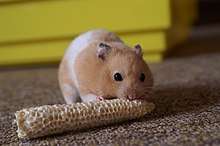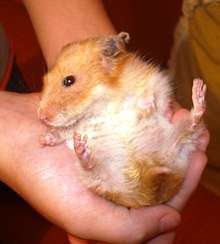Syrian hamster care
Syrian hamster care includes all the actions which a person might take to promote animal welfare in the Syrian hamster when it lives with humans either as a pet or laboratory animal.
Enclosure
There are some different recommendations for what cage size is appropriate for hamsters. HSS (Hamster Society Singapore) recommend a minimum unbroken floor space of 4000 cm2 (620 in2) for Syrian Hamsters.[1] While TVT (Tierärztliche Vereinigung für Tierschutz) recommend you give Syrian Hamsters as much space as you can and at minimum 100 cm x 50 cm x 50cm (L x W x H) which is a floor space of 5000 cm2 (775 in2).[2] BMEL ( Bundesministerium für Ernährung und Landwirtschaft, the German Federal Ministry of Food and Agriculture) like TVT also recommend a minimum of 5000 cm2 (775 in2) for Syrian Hamsters.[3]
The bedding should not be pine, cedarwood, soft wood, or corn cob shavings because those have been known to cause respiratory problems. Corn Cob shavings do not pose a threat to a hamster's respiratory system, but instead pose a threat to their weight, for this bedding is edible, and some hamsters enjoy nibbling it.[4] That increases the risk of obesity. Paper-Based bedding is much a safer alternative. The cage should also include an exercise wheel. The wheel must be an appropriate size for the hamster. For Syrian hamsters, a diameter of 9 inches is a minimum (studies have found that they prefer 14 inches.[5] The running surface cannot be wire or mesh because that can cause bumblefoot.) Silent spinner wheels are a good alternative. The cage should also provide a sheltering structure for sleeping; this can be as simple as an opaque tube closed at one end.[6]
Environment
Hamsters should experience light for 12–16 hours a day.[7] Among other health effects, daily exposure to light influences the estrous cycle of females and hamsters thrive with regular light.[7] Hamsters prefer humidity levels of 40-60%.[7][8] Breeding hamsters prefer a room temperature between 69 °F (21 °C) and 71 °F (22 °C), whereas hamsters who are not breeding prefer between 72 °F (22 °C) and 74 °F (23 °C).[7] Hamsters prefer quiet rooms and become stressed when sudden noise disturbs them.[9]
Diet

In the wild hamsters are omnivorous but mostly eat plants.[10]
For domesticated hamster researchers design diets to maximize growth, breeding, milk production in mothers, and the maintenance of health in adult hamsters.[10] The diet of the hamster is less studied than the diet of other laboratory rodents.[10] A typical nutrient recommendation for a hamster diet is 17-23% crude protein, 4.5% crude fat, and 6-8% crude fiber.[11] Hamster diet must include Vitamin E.[11] Vegetables which are good for hamsters include cucumber, carrots, celery, kale, and lettuce (however iceberg lettuce isn't good for a hamster).[12] Apples are an appropriate fruit to offer.[12] Domestic hamsters begin to eat food pellets when they are 7–10 days old.[11] Every day adult hamsters eat 7-15 grams of the food. Food should not only consist of pellets, so a mix of seeds and other hamster-safe ingredients is best. Treats are not important to hamster's health but will increase their trust in you if hand-fed.
Treats such as sunflower seeds and yogurt drops are great for hamsters; though do be aware that yogurt drops must only be given at most once a week because of the amount of sugar in them. Any more than once a week is too much sugar for a hamster.[13]
Hamsters will drink up to 10ml of water for every 100g of hamster bodyweight.[13] Nursing mother hamsters will want extra water.[13] It can be difficult to provide fresh water to hamsters in a water dish because they are likely to soil the dish with bedding and need it changed twice daily.[14] Water bowls are very easy to clean, and have a very natural drinking angle. Water bottles in cages must be positioned at a height which the hamster can reach without stretching.
Hamsters hoard their food, and will carry it from where they find it to a hiding place.[13] They seem to not care whether their food is served in a dish or placed on their floor.[15] Uneaten fresh vegetables should be removed after a day or so to prevent rotting.[12]
Handling

Hamsters that are frequently and gently handled will learn to respond peacefully to being handled. However, enforcing trust by taming is very important. [16] When hamsters bite, they bite in front of them.[17] A typical hamster-holding technique is to grasp the hamster from above around its belly with a thumb and the third finger.[17] With two hands, a hamster may be cupped and held while left free to walk on the palms.[17] Sleeping hamsters often bite when disturbed.[16] Allow a hamster several days to become familiar with its new home, and you. Then, gently offer it treats, which it will shortly take from your palm, beginning its willingness to be handled.[18]
It is important for a pet’s safety that owners know hamsters will jump from any platform without regard for height or consideration for their wellbeing.[16]
Hamsters are less likely to bite a bare hand than a gloved one.[16] If a hamster seems like it might bite, but must be handled, it may be collected by allowing it to explore a can or jar.[16]
Exercise wheels
TVT (Tierärztliche Vereinigung für Tierschutz) recommend wheels should be at least 30cm for Syrian Hamsters, since smaller diameters lead to permanent spinal curvatures, especially in young animals. They also recommend a solid running surface because rungs or mesh can cause injury.[19]
Avoid using wire and mesh exercise wheels to protect them[20] from such conditions as bumblefoot, a painful inflammation of their foot pads.[21]
Domestication
In the first ten years after the 1930 start of the domestication of the Syrian hamster, 70 scientific articles were published based on Syrian hamster research and 6 of those were concerned caring for hamsters.[22] In 1945 at the New York Academy of Science at a conference on animal colony maintenance there was a presentation including care of Syrian hamsters.[23] The 1947 first edition of the UFAW Handbook contained a chapter on the care of Syrian hamsters.[24] In 1950 The Care and Breeding of Laboratory Animals contained a chapter on Syrian hamster care with recommendations about cage size, handling hamsters, hamster diet, cleaning hamsters, and hamster breeding.[25] In 1960 the Institute of Laboratory Animal Resources published a guide on the care and breeding of Syrian hamsters.[26]
Notes
- Hamster Society Singapore
- Tierärztliche Vereinigung für Tierschutz e.V., Merkblatt Nr. 156 - Heimtiere: Goldhamster (Stand: 2014), pets: golden hamster, Housing
- Bundesministerium für Ernährung und Landwirtschaft, the German Federal Ministry of Food and Agriculture, Haltung von Säugetieren, 15.4.1 Enclosure requirements
- "Hamster Bedding: The Best Options". Hamster Bedding: The Best Options. 2014-10-02. Retrieved 15 December 2019.
- Reebs, S. G.; St-Onge, P (2005). "Running wheel choice by Syrian hamsters". Laboratory Animals. 39 (4): 442–451. doi:10.1258/002367705774286493. PMID 16197712.
- Veillette, M.; Reebs, S.G. (2011). "Shelter choice by Syrian hamsters (Mesocricetus auratus) in the laboratory". Animal Welfare. 20: 603–611.
- Magalhaes 1968, p. 16.
- This is the same as the human comfort level.
- Field 1999, p. 22.
- Field 1999, p. 24.
- Field 1999, p. 25.
- Magalhaes 1968, p. 19.
- Field 1999, p. 26.
- Logsdail 2002, p. 30.
- Logsdail 2002, p. 19.
- Magalhaes 1968, p. 20.
- Magalhaes 1968, p. 21.
- "Taming a Hamster!". Your Pet Hamster. Your Pet Hamster. Retrieved 16 December 2019.
- Tierärztliche Vereinigung für Tierschutz e.V., Merkblatt Nr. 62 - Heimtierhaltung, Tierschutzwidriges Zubehör (Stand: Jan. 2010), II. Anti-animal welfare accessories for small mammals, 7. Wheels
- "Minimum Size Wheel & Ball For A Syrian". HamsterHideout.
- "DANGERS OF HAMSTER WHEELS". Pets on Mom.
- Magalhaes 1968, p. 15 narrates the history by saying there were six, then references them as follows:
- Menahem, H.B. (September 1943). "Notes sur l'elevage du Hamster de Syrie, Cricetus auratus". Arch Inst Pasteur Algerie (12): 403–407.
- Hindle, H. M. Bruce and E. (1934). "The Golden Hamster, Cricetus (Mesocricetus) auratus Waterhouse. Notes on its Breeding and Growth". Proceedings of the Zoological Society of London. 104 (2): 361–366. doi:10.1111/j.1469-7998.1934.tb07757.x.
- Beiträge zur Biologie, insbesondere Fortpflanzungsbiologie des Hamsters (Cricetus cricetus L.). Ergebnisse und Probleme. (= Monographien der Wildsäugetiere. Band 1.) In: Zeitschrift für Kleintierkunde und Pelztierkunde. "Kleintier und Pelztier." Band 12, Nummer 1, 1936.
- Deanesly, Ruth (2009). "The Reproductive Cycle of the Golden Hamster (Cricetus auratus)". Proceedings of the Zoological Society of London. A108 (1): 31–37. doi:10.1111/j.1469-7998.1938.tb00019.x.
- Black, Sam H. (1939). "Breeding hamsters". International Journal of Leprosy. 7 (3): 412–414.
- Laidlaw, Patrick (1939). "Maintenance of the Golden Hamster". International Journal of Leprosy. 7 (4): 513–516.
- Magalhaes 1968, p. 13 discussing
- Cumming, C. N. W.; Carnochan, F. G. (1945). "Animal Colony Maintenance?financing and Budgeting; View-Point of the Commercial Breeder". Annals of the New York Academy of Sciences. 46 (1 Animal Colony): 115–126. Bibcode:1945NYASA..46..115C. doi:10.1111/j.1749-6632.1945.tb36164.x.
- Magalhaes 1968, p. 15 notes
- Hindle, E. (1947). "Chapter 15 - The Golden Hamster". In Worden, Alastair (ed.). UFAW Handbook. London: Bailliere Tindall and Cox. pp. 196–202.
- Magalhaes 1968, p. 15 gives this information about
- Poiley, S.M. (1950). "Breeding and care of the Syrian hamster". In Farris, E.J. (ed.). The Care and Breeding of Laboratory Animals. New York: John Wiley and Sons. pp. 118–152. ISBN 0471256080.
- Magalhaes 1968, p. 15.
References
- Magalhaes, Hulda (1968). "Housing, Care, and Breeding". In Hoffman, Roger A.; Robinson, Paul F.; Magalhaes, Hulda (eds.). The Golden Hamster - its biology and use in medical research (1 ed.). Ames, Iowa: Iowa State University Press. pp. 15–23.CS1 maint: ref=harv (link)
- Field, Karl J.; Sibold, Amber L. (1999). The laboratory hamster & gerbil. Boca Raton [u.a.]: CRC Press. ISBN 0849325668.
- Logsdail, Chris; Logsdail, Peter; Hovers, Kate (2002). Hamsterlopaedia : a complete guide to hamster care. Lydney: Ringpress. ISBN 1860542468.
External links
| Wikibooks has a book on the topic of: Animal Care/Hamster |
- How to Care for Syrian Hamsters by wikiHow
- SYRIAN HAMSTER CARE, a video review by YouTuber ChocolateColors26